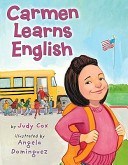
The first day of school can be scary, especially when no one else speaks your language. Carmen, who speaks only Spanish, knows she must be brave. Her teacher’s Spanish is muy terrible; but with a little encouragement from la Senora, Carmen teaches the class Spanish words and numbers, and she in turn learns English from her new friends.
This book has been included in WOW’s Language and Learning: Children’s and Young Adult Fiction Booklist. For our current list, visit our Booklist page under Resources in the green navigation bar.
- ISBN: 9780823421749
- Author: Cox, Judy
- Published: 2010 , Holiday House
- Themes: bilingualism, bullying, moving, New experiences, School, Spanish
- Descriptors: Latinx in US, Picture Book, Primary (ages 6-9), United States
- No. of pages: 32

For the last book comment of July, I want to highlight how friendship is often key in supporting individuals in overcoming difficult obstacles, but being a one’s own best friend is often the most powerful relationship of all.
This theme plays out in Judy Cox’s (2010) recently published and beautifully illustrated picture book Carmen Learns English. It is a story about Carmen, a little girl who speaks Spanish and is now entering an American, English speaking classroom for the first time. Told from Carmen’s perspective, the story documents her fears, her triumphs, and how her friendships with her sister, classmates, and teacher inspire her in light of her self doubts as a language user, but how in the end, it is the assurance she feels within that makes the biggest difference in becoming an important advocate for herself.
When I first read the book, I was skeptical about its content. I thought it was going to portray the learning of English as the ultimate and most important goal for Carmen. However, I surprised at how the story unfolded, attempting to show the richness of being able to speak multiple languages. This idea is illustrated in the relationship Carmen has with her teacher, Mrs. Coski, who tries to speak Spanish with Carmen. Carmen recognizes her teacher’s Spanish is “muy terrible” which gives her confidence to try English. When Carmen’s friend Mikki announces to the teacher that Carmen doesn’t say her numbers correctly, Mrs. Coski suggests that while Carmen learns English the rest of the class can learn Spanish, and Carmen thus becomes a teacher, too. When Carmen over hears boys on the playground putting down her “accent” Carmen has the poise to confront the boys, and feels confident with her bilingualism.
While I would welcome the input of native Spanish speakers on the accuracy of the book’s content both linguistically (particularly the code-switching) and culturally (though the publisher thanks NYU’s Dept. of Spanish and Portuguese for reviewing the Spanish in the book for correctness), I all in all like this book, and see it as being a welcome addition to a school or classroom library. Angela Dominguez’s illustrations are wonderful, capturing the spirit of the story. I was disappointed somewhat with the ending, which, like other popular multicultural picture books where a character overcomes doubts and racist assumptions such as Amazing Grace (Hoffman, 1991) and Home at Last (Elya, 2006), implies that now that Carmen is speaking English everything’s going to be okay, which could make an interesting inquiry for students to interrogate together, especially in light of the current political climate surrounding language policy and immigration. I am eager to hear other’s opinions and experiences with this book and to share this book with colleagues and students.